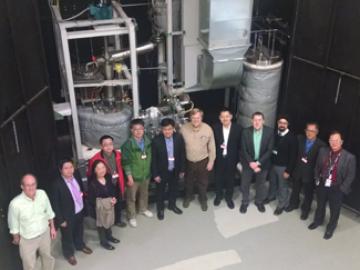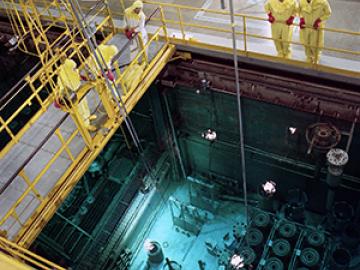
Filter News
Area of Research
- (-) Advanced Manufacturing (34)
- (-) Energy Frontier Research Centers (14)
- (-) National Security (79)
- (-) Nuclear Science and Technology (74)
- Biological Systems (18)
- Biology and Environment (177)
- Biology and Soft Matter (5)
- Building Technologies (12)
- Chemical and Engineering Materials (4)
- Chemistry and Physics at Interfaces (11)
- Clean Energy (522)
- Climate and Environmental Systems (14)
- Computational Biology (6)
- Computational Chemistry (5)
- Computational Engineering (5)
- Computer Science (19)
- Data (1)
- Earth Sciences (1)
- Electricity and Smart Grid (3)
- Energy Sciences (5)
- Fossil Energy (3)
- Fuel Cycle Science and Technology (3)
- Functional Materials for Energy (16)
- Fusion and Fission (54)
- Fusion Energy (17)
- Geographic Information Science and Technology (3)
- Isotope Development and Production (3)
- Isotopes (35)
- Materials (433)
- Materials Characterization (2)
- Materials for Computing (36)
- Materials Synthesis from Atoms to Systems (13)
- Materials Under Extremes (12)
- Mathematics (1)
- Neutron Data Analysis and Visualization (4)
- Neutron Science (190)
- Nuclear Systems Modeling, Simulation and Validation (3)
- Nuclear Systems Technology (1)
- Quantum Condensed Matter (4)
- Quantum information Science (9)
- Reactor Technology (1)
- Renewable Energy (4)
- Sensors and Controls (5)
- Supercomputing (311)
- Transportation Systems (11)
News Type
News Topics
- 3-D Printing/Advanced Manufacturing (27)
- Advanced Reactors (13)
- Artificial Intelligence (13)
- Big Data (6)
- Bioenergy (5)
- Biology (5)
- Biomedical (4)
- Biotechnology (1)
- Buildings (1)
- Chemical Sciences (2)
- Climate Change (5)
- Composites (3)
- Computer Science (22)
- Coronavirus (3)
- Cybersecurity (20)
- Decarbonization (3)
- Energy Storage (2)
- Environment (6)
- Exascale Computing (1)
- Frontier (1)
- Fusion (10)
- Grid (6)
- High-Performance Computing (4)
- Isotopes (5)
- Machine Learning (13)
- Materials (8)
- Materials Science (11)
- Molten Salt (4)
- Nanotechnology (2)
- National Security (34)
- Neutron Science (11)
- Nuclear Energy (41)
- Partnerships (4)
- Physics (3)
- Quantum Science (1)
- Security (11)
- Simulation (1)
- Space Exploration (6)
- Summit (2)
- Sustainable Energy (9)
- Transformational Challenge Reactor (4)
- Transportation (2)
Media Contacts

Representatives from the Oak Ridge National Laboratory (ORNL) and the Shanghai Institute of Applied Physics (SINAP) are meeting at ORNL this week as part of an agreement between the two institutions to work together on the advancement

Andrew Stack, a geochemist at the Department of Energy’s Oak Ridge National Laboratory, advances understanding of the dynamics of minerals underground.

Graphene, a strong, lightweight carbon honeycombed structure that’s only one atom thick, holds great promise for energy research and development. Recently scientists with the Fluid Interface Reactions, Structures, and Transport (FIRST) Energy Frontier Research Center (EFRC), led by the US Department of Energy’s Oak Ridge National Laboratory, revealed graphene can serve as a proton-selective permeable membrane, providing a new basis for streamlined and more efficient energy technologies such as improved fuel cells.


With a 3-D printed twist on an automotive icon, the Department of Energy’s Oak Ridge National Laboratory is showcasing additive manufacturing research at the 2015 North American International Auto Show in Detroit.


Researchers at the Department of Energy’s Oak Ridge National Laboratory have demonstrated an additive manufacturing method to control the structure and properties of metal components with precision unmatched by conventional manufacturing processes. Ryan D...





